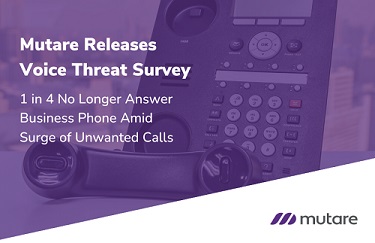Mutare Inc. released its 2023 Voice Network Threat Survey, which found that uncertainty remains across industries over how to protect against voice network attacks. Responses from cybersecurity and information technology professionals, Mutare found that 24 percent of respondents no longer answer their business phones as the amount of unwanted calls has skyrocketed.
What’s worse, 100 percent of respondents said voice threats have affected them negatively, an eye-opening statistic emphasizing the severity of the problem, which comes in the form of robocalls, spoof calls, scam calls, spam calls, spam storms, vishing (voice phishing), smishing (SMS, or text, phishing) and social engineering.
The Voice Network Threat Survey sought to gain insight into what impact nuisance and nefarious calls have on businesses, as well as what steps businesses take to safeguard themselves against outside threats.
The report found people are changing how they interact with the voice channel. In addition to the 24 percent of people who don’t answer their business phone, another 46 percent said they were cautious with unknown callers.
About half of the respondents have turned to training to solve the problem, but training alone is inadequate to address this threat.
Mutare’s Index of Unwanted Traffic shows year-over-year growth in the share of unwanted calls businesses received, with this year’s survey finding that an average of 10 percent of calls across industries are unwanted.
Tellingly, 28 percent of respondents have no idea what percentage of their voice traffic is unwanted, and 31 percent believe it is greater than one in 10 — showing that even though people recognize the problem, they don’t know how to measure it.
Nearly one in five respondents (19 percent) confirmed their organization experienced a voice-based attack in the last 12 months, while 49 percent said theirs had not.
However, a whopping 37 percent did not know if their organization faced an attack — which could indicate that companies are reluctant to disclose security incidents, even to their own employees.










